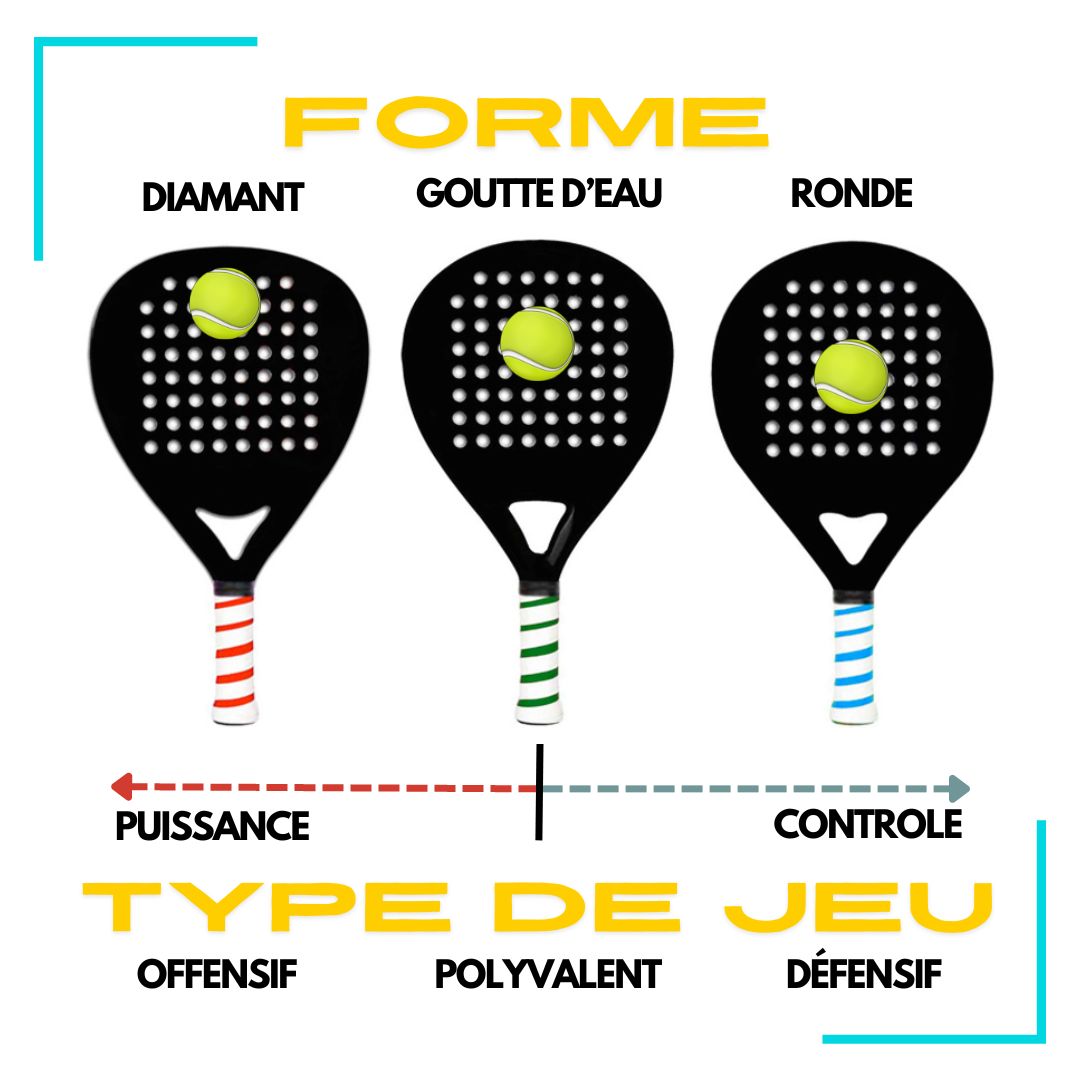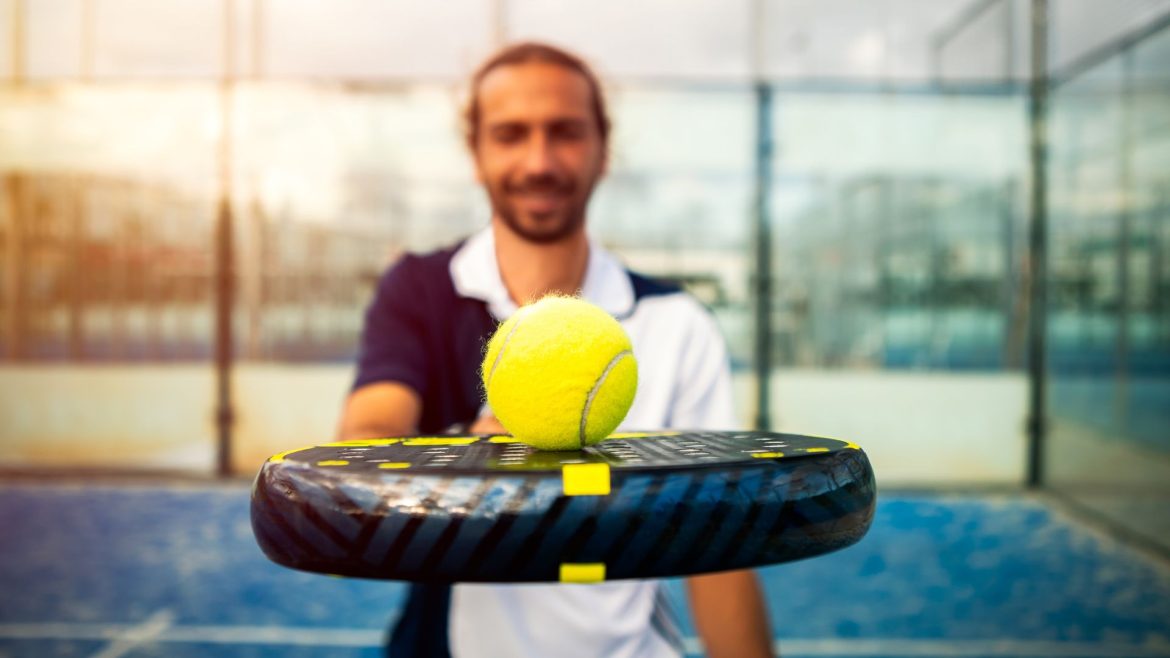Padel, the fast-growing racket sport, is attracting more and more fans across Europe and around the world. However, choosing the right padel racket can be difficult given the multitude of models and brands available. Whether you’re a beginner or an experienced player, it’s crucial to understand the differences between the different types of padel racquets so you can make a choice that’s right for you. This article aims to shed some light on the essential criteria to consider.
The Shapes of Paddle Rackets: Round, Waterdrop and Diamond
The shape of the racket is one of the most important criteria influencing the game. There are three main shapes: round, teardrop and diamond.

Shapes of padel rackets
Round Padel Racquets
Round padel rackets are characterised by a lower balance point and a larger hitting surface. They are ideal for beginners and players looking for more control and manoeuvrability. Thanks to their central sweet spot, they are forgiving of hitting errors and make it easier to learn the basics of padel.
Water Drop Paddle
The teardrop shape, often called “hybrid”, combines the advantages of round and diamond-shaped rackets. It offers a good balance between power and control. This shape is particularly popular with intermediate players. The sweet spot on these rackets is slightly off-centre, which increases versatility during exchanges.
Diamond Padel Racquets
Diamond-shaped paddle rackets are designed for advanced players looking for power. With a higher balance point and reduced sweet spot, they require a more refined technique. These rackets are ideal for attackers looking to inflict powerful, decisive shots.
The Composition and Materials of Padel Racquets
As well as the shape, the materials used to make the racket also influence performance on court. The main components to consider are the frame, the hitting surface and the core.
The frame
The racquet frame is generally made of carbon or fibreglass. Carbon fibre frames are stronger and lighter, offering greater durability and performance. Fibreglass frames, on the other hand, are more flexible and comfort-oriented, although slightly less resistant to impact.
The striking surface
The striking surface can be made of carbon, fibreglass or a combination of the two. Carbon surfaces provide greater rigidity and therefore power, while fibreglass surfaces offer greater flexibility and control. Some racquets also incorporate advanced technologies such as titanium coatings or graphene inserts for enhanced performance.
The Core
The racquet core can be made of EVA (ethylene vinyl acetate) or FOAM (polyurethane foam). EVA cores are known for their firmness, providing a drier, more direct feel. FOAM cores are softer, absorbing vibrations better, which reduces the risk of injuries such as tennis elbow.
Racquet weight: a determining factor
The weight of the racket is a crucial factor affecting your game. In general, paddle rackets weigh between 350 and 375 grams. Here’s how weight affects performance:
- Heavyweight (370-390 g): Ideal for players looking for more power in their shots. However, they require more effort and can tire the arm more quickly.
- Mediumweight (350-370g): The perfect compromise between power and control. Suitable for most players, from beginners to intermediates.
- Lightweight (330-350 g): Perfect for young players or those who prefer manoeuvrability and control. Also reduces the risk of arm injury.
Technology embedded in paddle rackets
Many brands incorporate advanced technologies to improve the performance of paddle rackets. Here are some common innovations:
Anti-Vibration System
Many rackets offer systems to reduce vibration, such as FOAM cores or specific inserts in the frame. This helps reduce the risk of injury and improves playing comfort.
Hole Pattern Technology
The layout of the holes in the racket can be varied to optimise manoeuvrability and aerodynamic resistance. The holes can be strategically placed to increase sweet spot and improve spin.
Reinforced frame structure
Some racquets feature reinforced frame structures for improved stability and durability, especially on powerful shots. These reinforcements increase rigidity and enable a more effective hit.
How do you choose the right paddle?
To make the right choice, you need to take into account a number of the items in this article, as well as your personal preferences. Here’s some practical advice:
- Determine your level: Whether you’re a beginner or an advanced player, choose a racket suited to your level to maximise your performance.
- Try different rackets: If possible, test several models to get a feel for the differences in weight, shape and materials.
- Read Reviews and Recommendations: Feedback from other players can help you identify the advantages and disadvantages of each racquet.
- Think about your style of play: Depending on your profile (attacker or defender), certain rackets will be better suited to your style of play.
By taking the time to analyse these different criteria, you’ll be able to choose the padel racquet that suits you best, optimising your performance and your enjoyment of the game.

